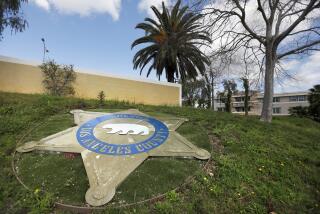Officer cleared in shooting releases transcripts
The Los Angeles police officer who fatally shot 13-year-old Devin Brown publicly released transcripts Friday from a meeting in which a disciplinary panel cleared him of wrongdoing.
The panel’s decision, reached earlier this week, outraged some city leaders because it was made in secret and rejected the civilian Police Commission’s finding that the shooting by Officer Steven Garcia was unjustified.
In a statement Friday, police union officials said Garcia waived his right to keep the proceedings confidential because he “recognizes the interests of the public in understanding the reasons” behind the panel’s decision.
“It is Officer Garcia’s hope that the release of this document will put the issue to rest,” the Los Angeles Police Protective League said. Transcripts of the panel’s decision were posted on the union’s website, www.lapd.com.
The 19-page rationale shows that two Los Angeles Police Department captains and a civilian representative cleared Garcia in a unanimous decision after considering testimony from many witnesses and experts, examining 52 exhibits and visiting the intersection of 83rd Street and Western Avenue, where the Feb. 6, 2005, shooting occurred.
“In essence, our decision has required that we put ourselves in Officer Garcia’s shoes and try to get inside his head,” said now-retired Capt. Bruce Crosley, who led the hearing by the so-called Board of Rights. “Was Garcia’s perception that his life was in imminent danger a reasonable one? Virtually all of the evidence ... tells us that it was.”
After a seven-minute pursuit in South Los Angeles, Garcia shot and killed Brown when the youngster backed a stolen Toyota Camry toward police. Garcia fired 10 rounds, striking Brown seven times.
In a report to the Police Commission, Chief William J. Bratton recommended that the panel rule the shooting justified. But in a 4-1 vote, commissioners disagreed and found it “out of policy.” The commission said the Camry was traveling less than 2 mph when Garcia opened fire. The commission also said evidence showed that Garcia had successfully moved out of the path of the car before he fired the first shot.
Garcia’s belief that his life was in danger “was not objectively reasonable,” the board concluded.
Crosley said he and his fellow panel members, Capt. Nancy Lauer and former police Commissioner Ann Reiss Lane, found Garcia to be “genuine and credible.” Crosley said they were well aware of the political and emotional implications of the case, but that “they bore no weight on our final decision.”
Evidence at the hearing showed that only about four seconds elapsed between the time Brown backed the car toward police and the time Garcia stopped shooting, according to the transcripts. When the Camry first started toward Garcia, it could have been going as fast as 12 mph, but when the officer opened fire it was traveling about 1 mph, the records show.
“The speed of the vehicle, at the time the first shot was fired
The transcripts show that the disciplinary panel relied heavily on the testimony of defense expert William Lewinski, a professor of police psychology at Minnesota State University, Mankato.
Lewinski said there is “lag time” that occurs between the point an officer perceives a threat and the time it takes for him to act on it. The board concluded that such a lag time explained how Garcia opened fire on Brown after he had stepped out of the car’s path.
Lewinski, transcripts show, also testified that “perceptions change” in stressful, fluid situations and that Garcia’s lateral movement in attempting to escape the car’s path “could well have caused him to see the slowing Camry as speeding toward him.”
Even though police commissioners found that all of Garcia’s shots were unjustified, Crosley noted that the department advocate prosecuting Garcia conceded at the beginning of the hearing that the initial six rounds could be considered “in policy,” according to the transcripts.
In an interview Friday, Lane, one of the board members, said she was struck by how quickly the incident unfolded and how close Garcia came to getting hit by the Camry.
“I focused on the four seconds of the incident and judged the case on the facts, not on the color or age of Devin Brown,” Lane said.
Earl Ofari Hutchinson, president of the Los Angeles Urban Policy Roundtable, who has been critical of the panel’s decision and the secrecy surrounding it, denounced the rationale Friday.
“The board selectively picked and chose the experts and evidence that tilted toward the officer,” he said in a statement.
“This further deepens suspicion that the board’s findings are tainted with officer bias and the boards are more interested in shielding officers from discipline than in an objective finding,” the statement said.
Meanwhile Friday, City Council members Jan Perry and Bernard C. Parks called for the Police Commission and the LAPD to make a presentation to the council on why the Board of Rights overturned the commission ruling on Garcia.
“This finding raises justifiable concerns at all levels of our community,” Perry said.
She also said she wanted the hearing to include a discussion of whether police disciplinary boards should be closed to the public, as was the case in the Garcia matter.
The Police Commission has scheduled a hearing for Tuesday to discuss whether Board of Rights hearings should be opened in ways that make the disciplinary process more transparent.
“Our problem is: Right now, based on the legal advice we have received, we have a legal noose around our necks,” commission President John Mack said, referring to City Atty. Rocky Delgadillo’s recommendation that LAPD disciplinary boards be closed.
Times staff writers Patrick McGreevy and Scott Glover contributed to this report.
More to Read
Start your day right
Sign up for Essential California for news, features and recommendations from the L.A. Times and beyond in your inbox six days a week.
You may occasionally receive promotional content from the Los Angeles Times.






